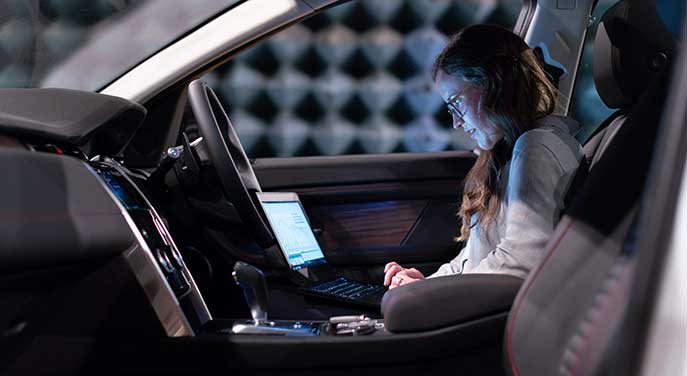
Photo by ThisisEngineering RAEng
Personal injury caused by car crashes are an all too common tragedy that occurs on America’s highways and byways on a daily basis. Now, with the introduction of self-driving, “autonomous” vehicles, the possibility for a harmful car crash just might seem even higher.
Or is it?
Self-driving cars are becoming more commonplace. What’s more is that studies show they will be safer than traditional vehicles.
For instance, you might back out of your driveway and your self-driving car sounds an alarm as another car passes by. It also applies the brakes on your behalf, thus avoiding a collision. Maybe you decide to manually control the car until you get to the highway when you press a button and the autonomous mode takes over. Someone cuts you off, and the car sounds another alarm, applies the brakes, shifts into another lane, and saves the day. When you get to work, the car parks itself on your behalf.
Autonomous self-driving cars are not the stuff of science fiction. The technology exists and is already being tested out in prototypes that are presently being driven on the public highways. Still, according to the Barnes Firm, a San Diego car accident lawyer, it’s important to stay safe while driving autonomous vehicles; even if you might be more safe, self-driving cars pose their own unique set of risks and several self-driving vehicle accidents have occured over the years. Here’s what you need to know:
Taking Over Control
Studies show that more than 90 percent of injurious and fatal car crashes are the result of human error. Drivers who drink and drive are especially dangerous and should be prosecuted to the full extent of the law, especially if their actions behind the wheel result in a personal injury to an innocent party. If you and/or a loved one is badly injured in a car crash that wasn’t your fault, you need to contact car wreck lawyers immediately.
Personal injury attorneys are not hard to find. If you’ve been in an accident, you can seek financial restitution. As we become accustomed to self-driving vehicles, the National Highway Traffic Safety Transportation Administration (NHTSA) is laser focused on autonomous vehicles that will take control of the car if it senses a collision is about to occur.
Says the NHTSA’s administrator, “For the past 40 years, we’ve been working on protecting people from the crash. This is the new North Star, making sure the crash never happens.”
Advanced safety systems are said to be showing great promise in the reduction of injurious and fatal crashes on present day roads. Here’s a sampling of some of these autonomous car safety system advances.
Seeing Down the Road
Forward-collision warning or FCW, is said to be one of the most promising features of the self-driving car. It works by using sensors and cameras that are able to monitor the distance between your vehicle and the one directly in front of it. If it senses you are in danger of colliding with the vehicle, a warning will sound. It might also “pre-charge the brakes” and tighten your seat-belt automatically. Some systems will brake the car on your behalf.
Additional Eyes
Lots of collisions occur when a vehicle runs into another vehicle not seen while changing lanes. But a new blind-spot monitoring system has been engineered that will alert the driver if another vehicle occupies the blind area beside and/or behind the car you’re driving.
If you activate your turn signal and another vehicle occupies your blind spot, an audible warning will sound telling you it’s unsafe to change lanes. This system is said to have worked well in numerous tests and studies by dramatically reducing the number of crashes.
Stay in the Lane
One of the most dangerous situations occurring on the highways is when a distracted or overly tired driver drifts out of his lane. But lane-departure warning or LDW is engineered to wake up a sleepy driver who’s about to veer out of his lane by issuing a loud warning. The system works by utilizing radar and cameras that can sense lane markers. It triggers a warning if the car begins to shift from its lane without a turn signal being activated first.
A few advanced systems are said to take control of the steering in order to keep the vehicle in the proper lane. New Jeep Cherokees will give the steering wheel “a tug” if the driver is coming dangerously close to shifting out of his lane without using his turn sigals, while the Mercedes-Benz S-Class utilizes a steering wheel vibration system to warn a distracted or sleepy driver.
This content is a joint venture between our publication and our partner. We do not endorse any product or service in the article.

